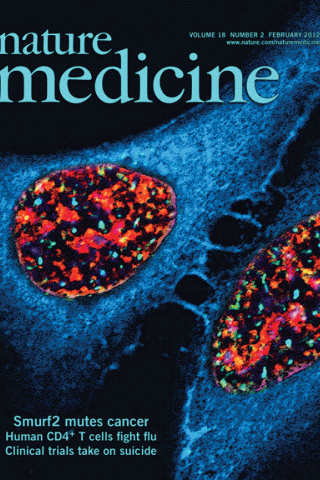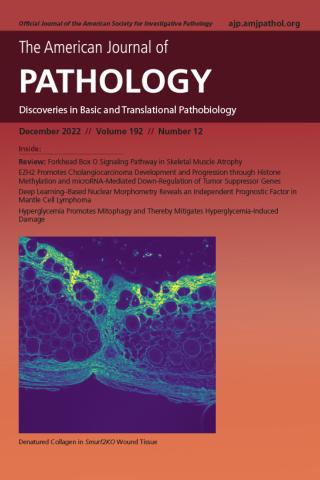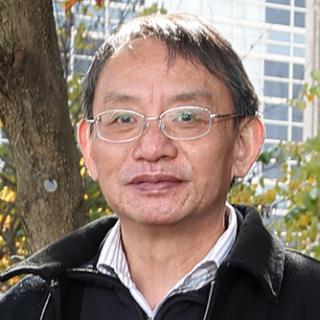
Ying E. Zhang, Ph.D.
- Center for Cancer Research
- National Cancer Institute
- Building 37, Room 2056B
- Bethesda, MD 20892-4256
- 240-760-6861
- zhangyin@mail.nih.gov
RESEARCH SUMMARY
Dr. Zhang's research focuses on understanding TGF-beta signaling and functions of ubiquitin E3 ligase Smurfs. She identified and characterized several key molecules in the TGF-beta signaling pathway, including Smads and Smurfs. Discoveries from her group generated mechanistic insight into how TGF-beta controls cellular responses through Smad-dependent and -independent pathways in normal and cancer cells. On the front of Smurf E3 ligases, their findings extended the function of Smurfs beyond TGF-beta pathway to genome stability and metastasis.
Areas of Expertise

Ying E. Zhang, Ph.D.
Research
TGF-beta and its related factors regulate a broad range of cellular functions, including proliferation, differentiation, apoptosis, migration and adhesion, and play very important roles in cancer and many other diseases. Our research focuses on three aspects of TGF-beta signaling in an attempt to gain further appreciation of its regulation, mechanisms of action and function in development and tumorigenesis. In order for proper TGF-beta signaling, the activity of Smad proteins is subject to stringent control, allowing alterations in the biological effects of ligands. A key event that regulates R-Smad activity is phosphorylation. Smad3 can be phosphorylated on cue of TGF-beta in the linker region in addition to the two C-terminal Ser residues. The linker sites are also phosphorylated by MAPK and CDK in response to mitotic signals. Previously, we created mouse liver cancer models by forced expression of Smad3 tissue-specifically in the liver using the Tet-off inducible system. we found that up-regulating Smad3 protects the liver against carcinogenic insult, and demonstrated that this tumor-protective role is afforded by the ability of Smad3 to down-regulate Bcl-2 transcription via p38 kinase (Cancer Cell 2006). This finding offers a new insight into designing novel approaches for treating the liver cancer. Recently, we discovered that Smad3 not only regulates transcription but also alternative splicing in the nucleus, which facilitates cancer progression by stimulating EMT and invasion (Molecular Cell 2016).
The second area of our research focused on the regulation of TGF-beta signaling modulators by ubiquitination, particularly the ubiquitin modification catalyzed by Smurf1 and Smurf2, which are HECT-domain E3 ligases. Resorting to mouse genetic approaches, we generated knockout alleles of both Smurf1 and Smurf2 genes to address their roles under physiological conditions. We found that Smurf1 and Smurf2 have both common and unique functions during embryogenesis and in maintaining adult physiological homeostasis. Our earlier work on characterizing Smurf1 knockout mice revealed a novel function of Smurf1 in the regulation of osteoblast function and bone homeostasis (Cell 2005), suggesting that targeting Smurf1 may prove to be an effective strategy for treating age-related bone losses in osteoporosis. Our recent work on characterizing Smurf2 knockout mice clarified contradictory reports in the literature about Smurf regulation of TGF-beta signaling by showing that Smurf2 indeed has an inhibitory role, but it does so by attenuating Smad3 activity through mono-ubiquitination rather than promoting its degradation as previously reported (EMBO J 2011). Our study also led to an unexpected discovery of a previously unrecognized function of Smurf2 as a tumor suppressor that normally maintains genomic stability by controlling epigenetic landscape of histone modifications via RNF20 (Nature Medicine 2012).
Finally, although Smads are involved in most actions of the TGF-beta superfamily, activated TGF-beta receptors also transduce signals through other intracellular signaling pathways, especially those mediated by MAP kinases (EMBO J. 2012). The third area of research of our research focuses on the specific mechanism by which TGF-beta receptors activate non-Smad pathways, and the biological significance of these Smad-independent pathways in TGF-beta signaling. Previously, we identified TRAF6 as the mediator of Smad-independent signaling conduit that exerts its control of downstream gene expression via activation of the JNK/p38 kinase (Molecular Cell 2008). Currently we are working to identify other downstream mediators that are responsible for Smad-independent TGF-beta receptor signaling using SILAC-based proteomic approaches. These studies could uncover novel molecular mechanisms that account for a number of Smad-independent TGF-beta signaling responses, and shed light on a decade-old puzzle of why tumor cells, which often develop a resistance to TGF-beta-induced growth inhibition as they progress, can retain an otherwise functional TGF-beta signaling pathway.
Publications
- Bibliography Link
- View Dr. Zhang's NCBI Bibliography.
TGF-β-induced Alternative Splicing of TAK1 Promotes EMT and Drug Resistance
Mechanistic Insight Into Contextual TGF-β Signaling
Non-proteolytic ubiquitin modification of PPARγ by Smurf1 protects the liver from steatosis
Transforming Growth Factor-β (TGF-β) Directly Activates the JAK1-STAT3 Axis to Induce Hepatic Fibrosis in Coordination with the SMAD Pathway
Direct Regulation of Alternative Splicing by SMAD3 through PCBP1 Is Essential to the Tumor-Promoting Role of TGF-beta.
Biography

Ying E. Zhang, Ph.D.
Dr. Ying Zhang received her B.S. degree in Chemistry and M.S. degree in Biochemistry from Peking University, China. She obtained her Ph.D. degree from University of Wisconsin-Madison in 1995 and completed her postdoctoral training with Dr. Rik Derynck in University of California, San Francisco. She joined the Laboratory of Cellular and Molecular Biology in 2000 as a tenure-track investigator and became a senior investigator in 2007.
Honors and Awards
Dr. Zhang was elected as an American Institute For Medical and Biological Engineering (AIMBE) Fellow in 2020 and an American Association for the Advancement of Science (AAAS) Fellow in 2021. She was also a recipient of several awards throughout her career at NIH, including the NCI Director’s Innovation Award (2006), the NCI Merit Award (2007), the NIH APAO Outstanding Scientific Award (2011) and the NCI Outstanding Mentor Award (2016).
Job Vacancies
We have no open positions in our group at this time, please check back later.
To see all available positions at CCR, take a look at our Careers page. You can also subscribe to receive CCR's latest job and training opportunities in your inbox.
Team
News
Ying Zhang’s research featured in NIH Intramural Research Program blog The blog post, “Scientific Detour Advances Understanding of Fatty Liver Disease," focuses on Dr. Zhang’s research, including a recent study that could eventually lead to preventing or reversing unhealthy amounts of fat storage in the liver. Read more...
Ying Zhang was elected to the 2021 class of American Association for the Advancement of Science (AAAS) Fellows.
Covers

A tumor suppressor function of Smurf2 associated with controlling chromatin landscape and genome stability through RNF20
About the Cover:
The cover shows the co-localization of Smurf2 with DNA damage markers in the nuclei of human osteosarcoma cells.
Abstract:
In addition to allelic mutations, cancers are known to harbor alterations in their chromatin landscape. Here we show that genomic ablation of Smad ubiquitin regulatory factor 2 (Smurf2), a HECT-domain E3 ubiquitin ligase, results in dysregulation of both the DNA damage response and genomic stability, culminating in increased susceptibility to various types of cancers in aged mice. We show that Smurf2 regulates the monoubiquitination of histone H2B as well as the trimethylation of histone H3 at Lys4 and Lys79 by targeting ring finger protein 20 (RNF20) for proteasomal degradation in both mouse and human cells. We also show that Smurf2 and RNF20 are colocalized at the γ-H2AX foci of double-stranded DNA breaks in the nucleus. Thus, Smurf2 has a tumor suppression function that normally maintains genomic stability by controlling the epigenetic landscape of histone modifications through RNF20.
A tumor suppressor function of Smurf2 associated with controlling chromatin landscape and genome stability through RNF20. Blank M, Tang Y, Yamashita M, Burkett SS, Cheng SY, Zhang YE. Nat Med. 2012 Jan 8;18(2):227-34.

Smurf2 regulates inflammation and collagen processing in cutaneous wound healing through TGF-b/Smad3 signaling
About the Cover:
Visualization of denatured collagen in Smurf2KO wound cross-section using the collagen hybridization peptide R-CHP. Denatured collagens can be observed in wound area but very little in the subdermal tissue around the wound after 14 days.
Abstract:
Wound healing is a highly conserved process that restores the integrity and functionality of injured tissues. TGF-b is a master regulator of wound healing, whose signaling is attenuated by the E3 ubiquitin ligase Smurf2. Here, the roles of Smurf2 in cutaneous wound healing were examined using a murine incisional cutaneous model. We found that loss of Smurf2 increased early inflammation in the wounds and led to narrower wounds with greater breaking strength. Loss of Smurf2 also led to more linearized collagen bundles in normal and wounded skin. Gene expression analyses by RT-qPCR indicated that Smurf2-deficient fibroblasts had increased levels of TGF-b/Smad3 signaling and changes in expression profile of genes related to matrix turnover. The effect of Smurf2 loss on wound healing and collagen bundling was attenuated by the heterozygous loss of Smad3. Together, these results show that Smurf2 affects inflammation and collagen processing in cutaneous wounds by down-regulating TGF-b/Smad3 signaling.
Smurf2 regulates inflammation and collagen processing in cutaneous wound healing through TGF-b/Smad3 signaling. Stuelten CH, Melis N, Subramanian B, Tang Y, Kimicata M, Fisher JP, Weight R, Zhang YE. Am J Pathol. 2022, Dec; 192(12):1699-1711.






